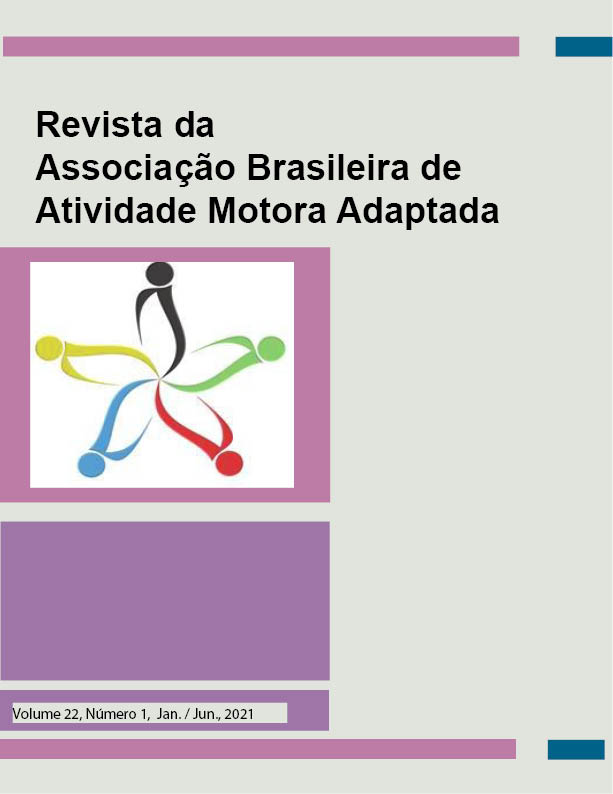AEROBIC CAPACITY OF GOALBALL PLAYERS: CASE STUDY OF A SOUTH COUNTRY TEAM
DOI:
https://doi.org/10.36311/2674-8681.2021.v22n1.p27-38Keywords:
Adapted Motor Activity, Goalball, Aerobic CapacityAbstract
Goalball is a specific sport for people with visual impairments. The game requires high levels of tactile, auditory and spatial awareness and it demands intermittent high intensity efforts supported predominantly by aerobic metabolism. Thus, the aim of this research report was to analyze the aerobic capacity of the goalball athletes of south country team, after a period of stoppage (vacation). For this purpose, three goalball players, aged between 27 and 49 years old, and practice time of 9 ± 6 years participated in the study. The test used for the evaluation was the modified Beep that has been validated to measure the aerobic capacity of athletes with visual impairment. The data were treated using descriptive statistics. The VO2max estimate was calculated using the modified beep test validation regression equation. As a result, the players presented VO2max of 33.1 ± 9.5 ml/Kg.min. When analyzing individually, only one of the players has aerobic capacity similar to that of elite athletes from male teams in the country. It is concluded that the aerobic capacity of these players needs to be better developed to accord the demands required in the game that can assist in a better performance.
Received on: 2021/06/30
Reformulated on: 2021/01/14
Accepted: 2021/01/15
References
AMORIM, M. et al. Goalball: uma modalidade desportiva de competição. Revista Portuguesa de Ciências do Desporto, v. 10, n. 1, p. 221-229, 2010.
AÑEZ, C. R. R.; HINO, A. A. F. Manual prático para a aplicação do teste de Vai-e-Vem (20m) de Léger. GPAQ–Grupo de Pesquisa em Atividade Física e Qualidade de Vida, v. 2, p. 2003, 2017.
ÇOLAK, T. et al. Physical fitness levels of blind and visually impaired goalball team players. Isokinetics and exercise science, v. 12, n. 4, p. 247-252, 2004.
FURTADO, da C. O. L. P. et al. Health-related physical fitness among young goalball players with visual impairments. Journal of Visual Impairment & Blindness, v. 110, n. 4, p. 257-267, 2016.
GAMERO, D.H. et al. A avaliação da potência de membros superiores no goalball: teste de arremesso de medicine ball. In: Anais do IV Congresso de Ciências do Desporto. 2011, UNICAMP. São Paulo: [s.n.], 2011. p.1.
Comitê Paralímpico Brasileiro (CPB). Goalball. [s.d.]. Disponível em: https://www.cpb.org.br/modalidades/56/goalball. Acesso em: 12 de junho, 2020.
Confederação Brasileira de Desportos de Deficientes Visuais (CBDV). Goalball [s.d.]. Disponível em: http://cbdv.org.br/goalball. Acesso em: 25 jun. 2020.
Confederação Brasileira de Desportos de Deficientes Visuais (CBDV). Goalball [s.d.]. Disponível em: http://cbdv.org.br/goalball. Acesso em: 25 jun. 2020.
GOOSEY-TOLFREY, V. L.; LEICHT, C. A. Field-based physiological testing of wheelchair athletes. Sports medicine, v. 43, n. 2, p. 77-91, 2013.
GOULART-SIQUEIRA, G. et al. Relationships between different field test performance measures in elite goalball players. Sports, v. 7, n. 1, p. 6, 2019.
GULICK, D. T: MALONE, L. A. Field test for measuring aerobic capacity in Paralympic goalball athletes. International Journal of Athletic Therapy and Training. V.16. n.5. p.22-25.2011.
INTERNATIONAL BLINDSPORTS FEDERATION (IBSA): Goalball rules and regulations 2018 – 2021. IBSA INTERNATIONAL BLIND SPORTS FEDERATION. Disponível em: https://www.ibsasport.org/sports/files/1180-Rules-2018-2021-IBSA-Goalball-Rules-and-Regulations-(Effective:--6-May-2020).pdf. Acesso em 27 jun. 2020
KARAKAYA, ?. Ç.; AKI, E.; ERGUN, N.. Physical fitness of visually impaired adolescent goalball players. Perceptual and motor skills, v. 108, n. 1, p. 129-136, 2009.
MAUERBERG DE CASTRO, E. et al. Fatores que afetam a carreira esportiva de alto rendimento do atleta com deficiência: uma análise crítica. Revista da Associação Brasileira de Atividade Motora Adaptada, v. 17, n. 2, 2016.
MAUERBERG DE CASTRO, E. ; CAMPBELL, D. F.; TAVARES, C. P. The global reality of the Paralympic Movement: Challenges and opportunities in disability sports. Motriz: Revista de Educação Física, v. 22, n. 3, p. 111-123, 2016.
MEDEIROS, J.F. Capacidade cardiorrespiratória de homens sedentários como componentes da aptidão física relacionada à saúde. Revista Digital. Buenos Aires, v. 16, n. 157, 2011.
PEREIRA, F. L. et al. Análise Comparativa entre Teste Direto e Indireto para Predição de VO2máx em Jogadores de Futsal Universitário. EFDesporte Revista Digital, v. 15, p. 148, 2010.
TOSIM, A. et al. Sistemas técnicos e táticos no goalball. Revista Mackenzie de Educação Física e Esporte, v.7, n. 2, 2008
THEOPHILOS, P. et al. Heart rate responses and blood lactate concentration of goalball players during the game. In: Proceedings of the 10th Annual Congress of the European College of Sport Science. 2005.




